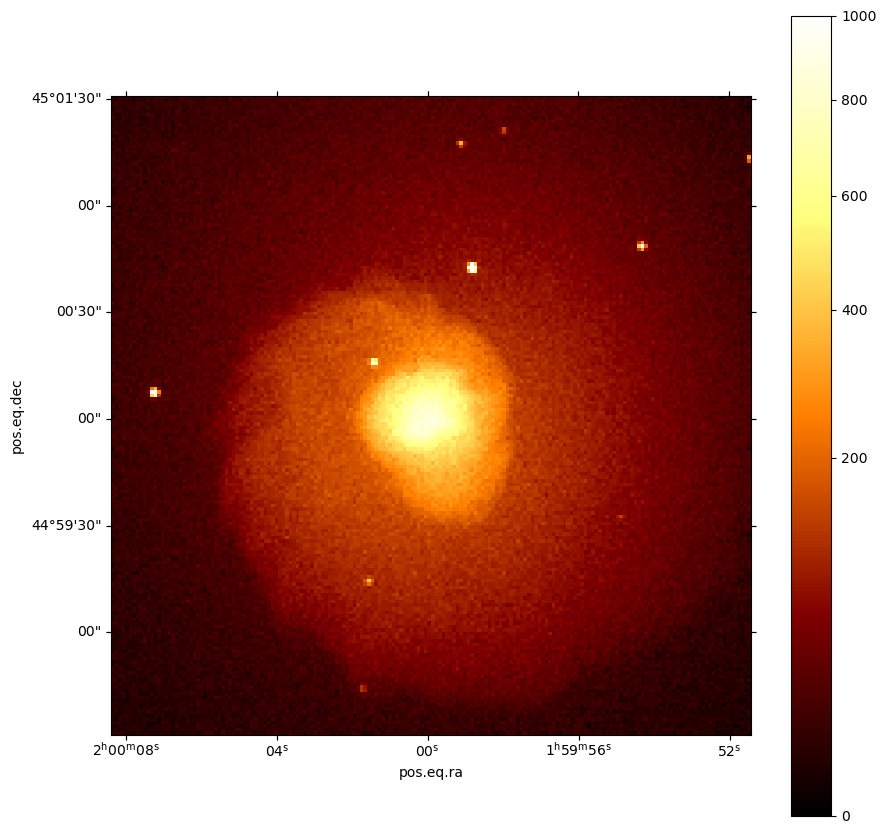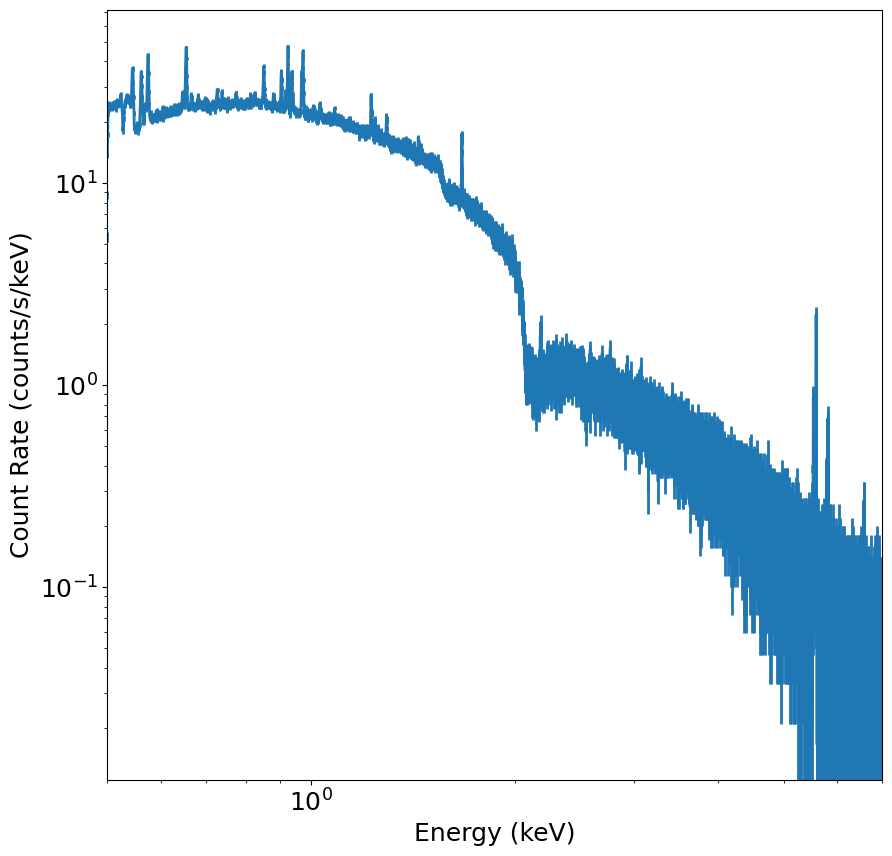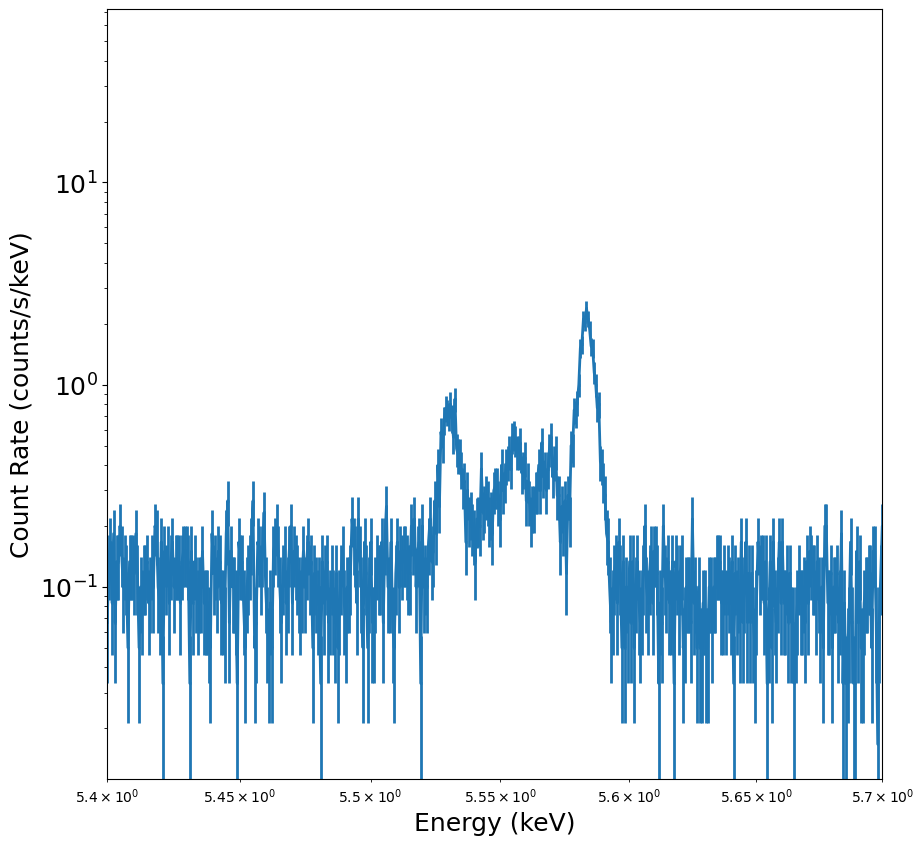pyXSIM Example¶
To show how to make a set of photons from a 3D dataset using pyXSIM and yt for reading into SOXS, we’ll look at is that of thermal emission from a galaxy cluster. In this case, the gas in the core of the cluster is “sloshing” in the center, producing spiral-shaped cold fronts. The dataset we want to use for this example is available for download from the yt Project at this link.
First, import our necessary modules:
[1]:
import yt
import pyxsim
import soxs
Next, we load the dataset with yt (this dataset does not have species fields, so we specify that the gas is fully ionized in this case so that the emission measure field can be computed correctly):
[2]:
ds = yt.load(
"GasSloshing/sloshing_nomag2_hdf5_plt_cnt_0150", default_species_fields="ionized"
)
yt : [INFO ] 2026-01-06 14:08:46,363 Parameters: current_time = 1.1835090993823291e+17
yt : [INFO ] 2026-01-06 14:08:46,363 Parameters: domain_dimensions = [16 16 16]
yt : [INFO ] 2026-01-06 14:08:46,364 Parameters: domain_left_edge = [-3.70272e+24 -3.70272e+24 -3.70272e+24]
yt : [INFO ] 2026-01-06 14:08:46,364 Parameters: domain_right_edge = [3.70272e+24 3.70272e+24 3.70272e+24]
yt : [INFO ] 2026-01-06 14:08:46,364 Parameters: cosmological_simulation = 0
Let’s use yt to take a slice of density and temperature through the center of the dataset so we can see what we’re looking at:
[3]:
slc = yt.SlicePlot(
ds, "z", [("gas", "density"), ("gas", "temperature")], width=(1.0, "Mpc")
)
slc.show()
yt : [INFO ] 2026-01-06 14:08:46,791 xlim = -1542838790481162406985728.000000 1542838790481162406985728.000000
yt : [INFO ] 2026-01-06 14:08:46,791 ylim = -1542838790481162406985728.000000 1542838790481162406985728.000000
yt : [INFO ] 2026-01-06 14:08:46,792 xlim = -1542838790481162406985728.000000 1542838790481162406985728.000000
yt : [INFO ] 2026-01-06 14:08:46,792 ylim = -1542838790481162406985728.000000 1542838790481162406985728.000000
yt : [INFO ] 2026-01-06 14:08:46,793 Making a fixed resolution buffer of (('gas', 'temperature')) 800 by 800
yt : [INFO ] 2026-01-06 14:08:46,905 Making a fixed resolution buffer of (('gas', 'density')) 800 by 800
Ok, sloshing gas as advertised. Next, we’ll create a sphere object to serve as a source for the photons. Place it at the center of the domain with "c", and use a radius of 500 kpc:
[4]:
sp = ds.sphere("c", (0.5, "Mpc"))
Now, we need to set up the emission model for our source. We said we were going to look at the thermal emission from the hot plasma, so we’ll do that here by using ThermalSourceModel. The first four arguments are the name of the underlying spectral model, the maximum and minimum energies, and the number of bins in the spectrum. We’ve chosen these numbers so that the spectrum has an energy resolution of about 1 eV. Setting thermal_broad=True turns on thermal broadening. This simulation
does not include metallicity, so we’ll do something simple and say that it uses the above spectral model and the metallicity is a constant \(Z = 0.3~Z_\odot\):
[5]:
source_model = pyxsim.CIESourceModel(
"apec", 0.5, 9.0, 9000, thermal_broad=True, Zmet=0.3
)
pyxsim : [INFO ] 2026-01-06 14:08:47,505 kT_min = 0.025 keV
pyxsim : [INFO ] 2026-01-06 14:08:47,505 kT_max = 64 keV
We’re almost ready to go to generate the photons from this source, but first we should decide what our redshift, collecting area, and exposure time should be. Let’s pick big numbers, because remember the point of this first step is to create a Monte-Carlo sample from which to draw smaller sub-samples for mock observations. Note these are all (value, unit) tuples:
[6]:
exp_time = (300.0, "ks") # exposure time
area = (3.0, "m**2") # collecting area
redshift = 0.2
So, that’s everything–let’s create the photons!
[7]:
n_photons, n_cells = pyxsim.make_photons(
"my_photons", sp, redshift, area, exp_time, source_model
)
pyxsim : [INFO ] 2026-01-06 14:08:47,515 Cosmology: h = 0.71, omega_matter = 0.27, omega_lambda = 0.73
pyxsim : [INFO ] 2026-01-06 14:08:47,515 Using emission measure field '('gas', 'emission_measure')'.
pyxsim : [INFO ] 2026-01-06 14:08:47,516 Using temperature field '('gas', 'temperature')'.
pyxsim : [INFO ] 2026-01-06 14:14:50,591 Finished generating photons.
pyxsim : [INFO ] 2026-01-06 14:14:50,592 Number of photons generated: 21498151
pyxsim : [INFO ] 2026-01-06 14:14:50,593 Number of cells with photons: 4056101
Ok, that was easy. Now we have a photon list that we can use to create events, using the project_photons() function. To be realistic, we’re going to want to assume foreground Galactic absorption, using the “TBabs” absorption model and assuming a foreground absorption column of \(N_H = 4 \times 10^{20}~{\rm cm}^{-2}\). Here we’ll just do a simple projection along the z-axis, reducing the exposure time, and centering the photons at RA, Dec = (30, 45) degrees:
[8]:
n_events = pyxsim.project_photons(
"my_photons", "my_events", "z", (30.0, 45.0), absorb_model="tbabs", nH=0.04
)
pyxsim : [INFO ] 2026-01-06 14:14:50,627 Foreground galactic absorption: using the tbabs model and nH = 0.04.
pyxsim : [INFO ] 2026-01-06 14:14:59,739 Detected 19321873 events.
We can then use this event list that we wrote as an input to the instrument simulator in SOXS. We’ll use a smaller exposure time (100 ks instead of 500 ks), and observe it with the Lynx calorimeter:
[9]:
soxs.instrument_simulator(
"my_events.h5",
"evt.fits",
(100.0, "ks"),
"lynx_lxm",
[30.0, 45.0],
overwrite=True,
)
soxs : [INFO ] 2026-01-06 14:14:59,886 Simulating events from 1 sources using instrument lynx_lxm for 100 ks.
soxs : [INFO ] 2026-01-06 14:15:03,578 Scattering energies with RMF xrs_mucal_3.0eV.rmf.
soxs : [INFO ] 2026-01-06 14:15:08,299 Detected 2640431 events in total.
soxs : [INFO ] 2026-01-06 14:15:08,331 Adding background events.
soxs : [INFO ] 2026-01-06 14:15:08,409 Adding in point-source background.
soxs : [INFO ] 2026-01-06 14:15:08,972 Simulating events from 1 sources using instrument lynx_lxm for 100 ks.
soxs : [INFO ] 2026-01-06 14:15:09,077 Scattering energies with RMF xrs_mucal_3.0eV.rmf.
soxs : [INFO ] 2026-01-06 14:15:10,092 Detected 102857 events in total.
soxs : [INFO ] 2026-01-06 14:15:10,094 Generated 102857 photons from the point-source background.
soxs : [INFO ] 2026-01-06 14:15:10,095 Adding in astrophysical foreground.
soxs : [INFO ] 2026-01-06 14:15:26,284 Adding in instrumental background.
soxs : [INFO ] 2026-01-06 14:15:26,328 Making 83190 events from the galactic foreground.
soxs : [INFO ] 2026-01-06 14:15:26,328 Making 9051 events from the instrumental background.
soxs : [INFO ] 2026-01-06 14:15:26,517 Observation complete.
soxs : [INFO ] 2026-01-06 14:15:26,519 Writing events to file evt.fits.
We can use the write_image() function in SOXS to bin the events into an image and write them to a file, restricting the energies between 0.5 and 2.0 keV:
[10]:
soxs.write_image("evt.fits", "img.fits", emin=0.5, emax=2.0, overwrite=True)
We can show the resulting image:
[11]:
fig, ax = soxs.plot_image(
"img.fits", stretch="sqrt", cmap="afmhot", vmax=1000.0, width=0.05
)

We can also bin the events into a spectrum using write_spectrum() and write the spectrum to disk:
[12]:
soxs.write_spectrum("evt.fits", "evt.pha", overwrite=True)
and plot the spectrum using plot_spectrum():
[13]:
fig, ax, _ = soxs.plot_spectrum(
"evt.pha", xmin=0.5, xmax=7.0, xscale="log", yscale="log"
)

Let’s zoom into the region of the spectrum around the iron line to look at the detailed structure afforded by the resolution of the calorimeter:
[14]:
ax.set_xlim(5.4, 5.7)
fig
[14]:
